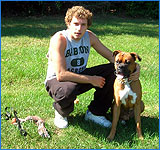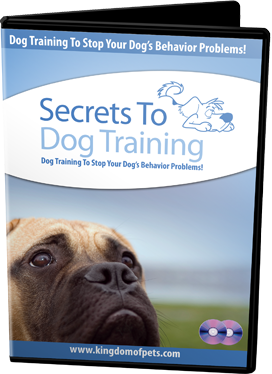If you are looking for the greatest gold-mine of easy to use "change your dog's behavior" advice ever crammed into a newsletter series then read on!
Also, make sure that you check out our 100% authentic testimonials from people who have bought Secrets to Dog Training and find out the massive difference it has made to their owner-dog relationship!
 "My name is Mitch Fletcher; I’m 22 years old and live in central Pennsylvania. I have a Boxer named Chopper who is about a year and a half old. He is excellent with my family, friends, and the general public. I am able to take him everywhere I go and spending time with him is what I look forward to everyday. The Sit Stay Fetch Books have helped me immensely in reaching the goals that I have for my dog.
"My name is Mitch Fletcher; I’m 22 years old and live in central Pennsylvania. I have a Boxer named Chopper who is about a year and a half old. He is excellent with my family, friends, and the general public. I am able to take him everywhere I go and spending time with him is what I look forward to everyday. The Sit Stay Fetch Books have helped me immensely in reaching the goals that I have for my dog.
From the basic obedience rules to the advanced training tips, I have used the recommendations and commands from Sit Stay Fetch and our success is clear. Placing my dog in a "sit, stay" and jogging over 200 yards away without looking back, then calling him in with the slightest recall is just one of our many inspiring routines. I am now getting into the dog whispering section, talk about connecting with your pup.
I recommend this book to everyone who has a dog, especially if they have specific areas where their dog needs help. The problem solving sections of the book are great. Happy Dog Training."
-- Mitch Fletcher (Pennsylvania, USA)
Hi Daniel,
Do you have any suggestions on what to feed my female German Shepherd to help with urine burning of grass?
Thanks,
Katy
Hi Katy,
Thanks for your email. Urine burning the lawn can be a very frustrating problem and quite difficult to manage. There are many home remedies to correct this problem, but most of them are ineffective and a few of them actually make the situation worse.
Before you start implementing changes to correct lawn burn, you need to make sure that your dog is actually the culprit. Several lawn diseases will look like lawn burn, with the small, characteristic brown patches. First, make sure that the brown spots are in areas where your dog urinates. Most dogs will have an area in the yard that they choose to use as the 'bathroom.' Secondly, make sure that the grass in the brown spots is still firmly attached. Grab a handful and give it a steady pull. If the grass is firmly rooted, then it points to lawn burn. If the whole bunch of grass pulls up, roots and all, then you may be dealing with a grub problem. And thirdly, make sure that your dog is the problem. If your neighbor's dog is coming into your yard and creating the problem it will not do any good to treat your own dog.
Because dog urine is very high in nitrogen, when your dog urinates it is similar to pouring liquid fertilizer on the lawn. A little fertilizer is good for the grass, but an excess causes nitrogen burn. The prevention of lawn burn deals with trying to reduce the amount of nitrogen coming into contact with the grass.
There are several contributing factors that increase the likelihood of developing lawn burn.
Female dogs are more likely to cause lawn burn than males because they void their entire bladder in one location instead of lifting their leg and marking, like males.
Large dogs deposit more urine so they increase the quantity of nitrogen in one location, making lawn burn more likely.
Those dogs, usually young active dogs, fed a high protein diet are more likely to produce urine that causes lawn burn.
Heavily fertilized yards are already receiving near maximum levels of nitrogen. The small amount of nitrogen in dog urine may be all that is needed to put these lawns over the edge and cause lawn burn.
Lawns that are stressed are more susceptible to damage. Lawns that are suffering from drought, disease, or are newly sodded or seeded are more susceptible to lawn burn.
Successfully treating and preventing lawn burn often requires a multi-step approach.
1. Saturate the urinated spots with water. After the pet urinates, pour several cupfuls of water on the spot to dilute the urine.
2. Feed a high quality dog food that does not exceed the pet's protein requirement. High quality foods have more digestible protein sources that are more completely utilized by the pet and create less nitrogenous waste in the urine. For this you will need to talk to your veterinarian to sort out the correct diet that suits your dog. Different dogs require different diets and often supermarket diets are quite ambiguous with their labeling.
3. Encouraging your dog to drink more, will help dilute the urine and decrease the risk of lawn burn. Small amounts of non-salted broth in the drinking water may help increase your dog's water intake.
4. Train your dog to urinate in a location that is less visible. This approach is very effective for some owners that do not want to add supplements to their dogs' diet.
5. Replant your yard with more urine-resistant grasses. The most resistant grasses tend to be perennial ryegrasses and fescues. The most sensitive tend to be Kentucky bluegrass and Bermuda.
6. Talk to your veterinarian about feeding your dog a supplement like Green-UM or Drs. Foster and Smith Lawn Guard, or apply a product to the lawn such as Dogonit Lawn Treatment. These products bind and neutralize the nitrogen in your pet's urine.
7. Reduce the stress on your lawn by not over- or under-fertilizing and by providing frequent watering.
8. If neighbors' dogs are causing the problem, you may advise your neighbors of the leash laws. Using a fence or motion-activated sprinkler may be helpful in keeping these dogs off of your lawn.
I hope this helps Katy.
Kind regards,
Daniel Stevens and the Secrets to Dog Training Team
"Secrets to Dog Training - STOP Dog Behavior Problems!"
 I've been a professional dog trainer for well over 20 years, and in that time I've helped thousands of dog owners just like you to get the friendly, well behaved, slipper fetching, best pal they always wanted.
I've been a professional dog trainer for well over 20 years, and in that time I've helped thousands of dog owners just like you to get the friendly, well behaved, slipper fetching, best pal they always wanted.
But it didn't start out that way. I've always loved dogs, some things never change. But when I first started my professional dog training career I relied on the so-called 'best practices' when it came to dog behavior training. It was only when I heard people tell me over and over again that they just weren't seeing results that I started to question the old accepted wisdom. So I started a journey, a quest to search out the best, most effective, techniques, tips, and tricks that really work.
And that's how I came up with Secrets to Dog Training. Year after year I found new techniques that achieved the results I wanted. Eventually I had a whole book worth of great resources: Secrets to Dog training...
So, if you want to:
Then Secrets to Dog Training is just what you've been looking for!
Previous newsletters
| 01 | 02 | 03 | 04 | 05 | 06 | 07 | 08 | 09 | 10 | 11 | 12 | 13 | 14 | 15 | 16 | 17 | 18 | 19 | 20 | 21 | 22 | 23 | 24 | 25 |
| 26 | 27 | 28 | 29 | 30 | 31 | 32 | 33 |34 | 35 | 36 | 37 | 38 | 39 | 40 | 41 | 42 | 43 | 44 | 45 |